5.1: Corn, Rice and Wheat
- Page ID
- 21217
\( \newcommand{\vecs}[1]{\overset { \scriptstyle \rightharpoonup} {\mathbf{#1}} } \)
\( \newcommand{\vecd}[1]{\overset{-\!-\!\rightharpoonup}{\vphantom{a}\smash {#1}}} \)
\( \newcommand{\id}{\mathrm{id}}\) \( \newcommand{\Span}{\mathrm{span}}\)
( \newcommand{\kernel}{\mathrm{null}\,}\) \( \newcommand{\range}{\mathrm{range}\,}\)
\( \newcommand{\RealPart}{\mathrm{Re}}\) \( \newcommand{\ImaginaryPart}{\mathrm{Im}}\)
\( \newcommand{\Argument}{\mathrm{Arg}}\) \( \newcommand{\norm}[1]{\| #1 \|}\)
\( \newcommand{\inner}[2]{\langle #1, #2 \rangle}\)
\( \newcommand{\Span}{\mathrm{span}}\)
\( \newcommand{\id}{\mathrm{id}}\)
\( \newcommand{\Span}{\mathrm{span}}\)
\( \newcommand{\kernel}{\mathrm{null}\,}\)
\( \newcommand{\range}{\mathrm{range}\,}\)
\( \newcommand{\RealPart}{\mathrm{Re}}\)
\( \newcommand{\ImaginaryPart}{\mathrm{Im}}\)
\( \newcommand{\Argument}{\mathrm{Arg}}\)
\( \newcommand{\norm}[1]{\| #1 \|}\)
\( \newcommand{\inner}[2]{\langle #1, #2 \rangle}\)
\( \newcommand{\Span}{\mathrm{span}}\) \( \newcommand{\AA}{\unicode[.8,0]{x212B}}\)
\( \newcommand{\vectorA}[1]{\vec{#1}} % arrow\)
\( \newcommand{\vectorAt}[1]{\vec{\text{#1}}} % arrow\)
\( \newcommand{\vectorB}[1]{\overset { \scriptstyle \rightharpoonup} {\mathbf{#1}} } \)
\( \newcommand{\vectorC}[1]{\textbf{#1}} \)
\( \newcommand{\vectorD}[1]{\overrightarrow{#1}} \)
\( \newcommand{\vectorDt}[1]{\overrightarrow{\text{#1}}} \)
\( \newcommand{\vectE}[1]{\overset{-\!-\!\rightharpoonup}{\vphantom{a}\smash{\mathbf {#1}}}} \)
\( \newcommand{\vecs}[1]{\overset { \scriptstyle \rightharpoonup} {\mathbf{#1}} } \)
\( \newcommand{\vecd}[1]{\overset{-\!-\!\rightharpoonup}{\vphantom{a}\smash {#1}}} \)
\(\newcommand{\avec}{\mathbf a}\) \(\newcommand{\bvec}{\mathbf b}\) \(\newcommand{\cvec}{\mathbf c}\) \(\newcommand{\dvec}{\mathbf d}\) \(\newcommand{\dtil}{\widetilde{\mathbf d}}\) \(\newcommand{\evec}{\mathbf e}\) \(\newcommand{\fvec}{\mathbf f}\) \(\newcommand{\nvec}{\mathbf n}\) \(\newcommand{\pvec}{\mathbf p}\) \(\newcommand{\qvec}{\mathbf q}\) \(\newcommand{\svec}{\mathbf s}\) \(\newcommand{\tvec}{\mathbf t}\) \(\newcommand{\uvec}{\mathbf u}\) \(\newcommand{\vvec}{\mathbf v}\) \(\newcommand{\wvec}{\mathbf w}\) \(\newcommand{\xvec}{\mathbf x}\) \(\newcommand{\yvec}{\mathbf y}\) \(\newcommand{\zvec}{\mathbf z}\) \(\newcommand{\rvec}{\mathbf r}\) \(\newcommand{\mvec}{\mathbf m}\) \(\newcommand{\zerovec}{\mathbf 0}\) \(\newcommand{\onevec}{\mathbf 1}\) \(\newcommand{\real}{\mathbb R}\) \(\newcommand{\twovec}[2]{\left[\begin{array}{r}#1 \\ #2 \end{array}\right]}\) \(\newcommand{\ctwovec}[2]{\left[\begin{array}{c}#1 \\ #2 \end{array}\right]}\) \(\newcommand{\threevec}[3]{\left[\begin{array}{r}#1 \\ #2 \\ #3 \end{array}\right]}\) \(\newcommand{\cthreevec}[3]{\left[\begin{array}{c}#1 \\ #2 \\ #3 \end{array}\right]}\) \(\newcommand{\fourvec}[4]{\left[\begin{array}{r}#1 \\ #2 \\ #3 \\ #4 \end{array}\right]}\) \(\newcommand{\cfourvec}[4]{\left[\begin{array}{c}#1 \\ #2 \\ #3 \\ #4 \end{array}\right]}\) \(\newcommand{\fivevec}[5]{\left[\begin{array}{r}#1 \\ #2 \\ #3 \\ #4 \\ #5 \\ \end{array}\right]}\) \(\newcommand{\cfivevec}[5]{\left[\begin{array}{c}#1 \\ #2 \\ #3 \\ #4 \\ #5 \\ \end{array}\right]}\) \(\newcommand{\mattwo}[4]{\left[\begin{array}{rr}#1 \amp #2 \\ #3 \amp #4 \\ \end{array}\right]}\) \(\newcommand{\laspan}[1]{\text{Span}\{#1\}}\) \(\newcommand{\bcal}{\cal B}\) \(\newcommand{\ccal}{\cal C}\) \(\newcommand{\scal}{\cal S}\) \(\newcommand{\wcal}{\cal W}\) \(\newcommand{\ecal}{\cal E}\) \(\newcommand{\coords}[2]{\left\{#1\right\}_{#2}}\) \(\newcommand{\gray}[1]{\color{gray}{#1}}\) \(\newcommand{\lgray}[1]{\color{lightgray}{#1}}\) \(\newcommand{\rank}{\operatorname{rank}}\) \(\newcommand{\row}{\text{Row}}\) \(\newcommand{\col}{\text{Col}}\) \(\renewcommand{\row}{\text{Row}}\) \(\newcommand{\nul}{\text{Nul}}\) \(\newcommand{\var}{\text{Var}}\) \(\newcommand{\corr}{\text{corr}}\) \(\newcommand{\len}[1]{\left|#1\right|}\) \(\newcommand{\bbar}{\overline{\bvec}}\) \(\newcommand{\bhat}{\widehat{\bvec}}\) \(\newcommand{\bperp}{\bvec^\perp}\) \(\newcommand{\xhat}{\widehat{\xvec}}\) \(\newcommand{\vhat}{\widehat{\vvec}}\) \(\newcommand{\uhat}{\widehat{\uvec}}\) \(\newcommand{\what}{\widehat{\wvec}}\) \(\newcommand{\Sighat}{\widehat{\Sigma}}\) \(\newcommand{\lt}{<}\) \(\newcommand{\gt}{>}\) \(\newcommand{\amp}{&}\) \(\definecolor{fillinmathshade}{gray}{0.9}\)Botanically, grains are grasses that bear edible seeds. Corn, rice and wheat are the most significant. Both the fruit (that is, the seed or kernel) and the plant are called a grain.
Most grain kernels are protected by a hull or husk. All kernels are composed of three distinct parts: the bran, endosperm and germ. The bran is the tough outer layer covering the endosperm. Bran is a good source of fiber and B-complex vitamins. The endosperm is the largest part of the kernel and is a source of protein and carbohydrates (starch). It is the part used primarily in milled products such as flour. The germ is the smallest portion of the grain and is the only part that contains fat. It is also rich in thiamin. The bran, endosperm and germ can be separated by milling.
This section presents information on corn, rice and wheat as well as several minor grains that are nutritionally significant and gaining popularity.
Some products are available in a stone-ground form. This means that the grains were ground with a stone mill rather than by the steel blades typically used for cracking, grinding, hulling and pearling. Stone grinders are gentler and more precise, so they are less likely to overgrind the grain. Stoneground products will always be labeled as such and are usually more expensive than steel-ground ones.
Corn
Corn is the only grain that is also eaten fresh as a vegetable. Its use as a dried grain dates back several thousand years in Central America and long preceded its use as a vegetable.
Cornmeal
Cornmeal is made by drying and grinding a special type of corn known as dent, which may be yellow, white or blue. Cornmeal is most often used in breads, as a coating for fried foods or cooked as polenta or mush. Products made with cornmeal have a gritty texture and a sweet but starchy flavor.
Hominy
Hominy, also known as ‘posole’ or ‘samp’ is dried corn that has been soaked in hydrated lime or lye. This causes the kernels to swell, loosening the hulls. The hulls and germs are removed and the kernels dried. These white or yellow kernels resemble popcorn, but with a soft, chewy texture and smoky-sour flavor. Hominy is available dried or cooked and canned. It may be served as a side dish or used in stews or soups. Masa harina, a finely ground flour made from dried hominy, is used for making breads, tortillas, tamales and other Mexican and southwestern dishes.
Grits
Grits are traditionally made by grinding dried hominy. These tiny white granules may be used in baked dishes but are most often served as a hot breakfast cereal, usually topped with butter or cheese. Quick-cooking and instant grits are available.
Rice
Rice is the starchy seed of a semiaquatic grass. Probably originating on the Indian subcontinent or in Southeast Asia, rice is used as a staple by more than half the world's population.
Rice can be incorporated into almost any cuisine, from Asian to Spanish to classic French. Its flavor adapts to the foods and seasonings with which the rice is cooked or served. Its texture adds an appealing chewiness to meat and poultry dishes, salads, breads and puddings. Rice is not limited to a side dish, but may be used in stews or curries; for stuffing vegetables or game birds; and in puddings, salads, beverages (such as Mexican horchata) and breads.
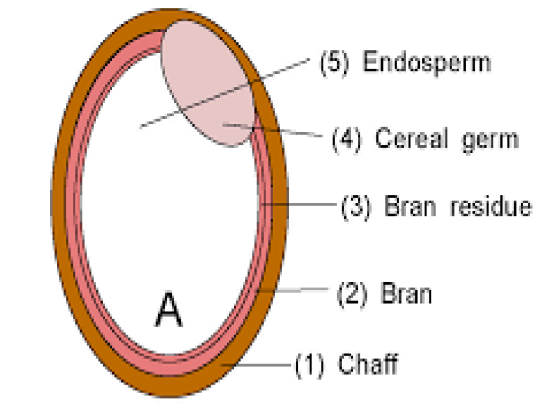
Rice is divided into three types based on seed size: long-grain, medium grain and short-grain. Long-grain rice is the most versatile and popular worldwide. The grains remain firm, fluffy and separate when cooked. (Long grain rice can, however, become sticky if overcooked or stirred frequently during cooking.) Short-grain rice has more starch and becomes quite tender and sticky when cooked. Italian risotto, Japanese sushi and Spanish paella are all traditionally made with short-grain rice. The appearance and starch content of medium-grain rice falls somewhere in between. Medium-grain rice becomes sticky when cool, so it is best eaten freshly made and piping hot.
Long Grain Rice
Long-grain, medium-grain and short-grain rice are available in different processed forms. All rice is originally brown. The grains can be left whole, with the bran attached, for brown rice. On the other hand, they can be pearled for the more familiar polished white rice. Both brown rice and white rice can be processed into converted rice and instant rice.
Converted rice is parboiled to remove the surface starch. This procedure also forces nutrients from the bran into the grain's endosperm. Therefore, converted rice retains more nutrients than regular milled white rice, although the flavor is the same. Converted rice is neither pre-cooked nor instant; in fact, it cooks more slowly than regular milled white rice.
Instant or quick-cooking rice is widely available and useful if time is a concern. Instant rice is created by fully cooking and then flash freezing milled rice. Unfortunately, this processing removes some of the nutrients and flavor.
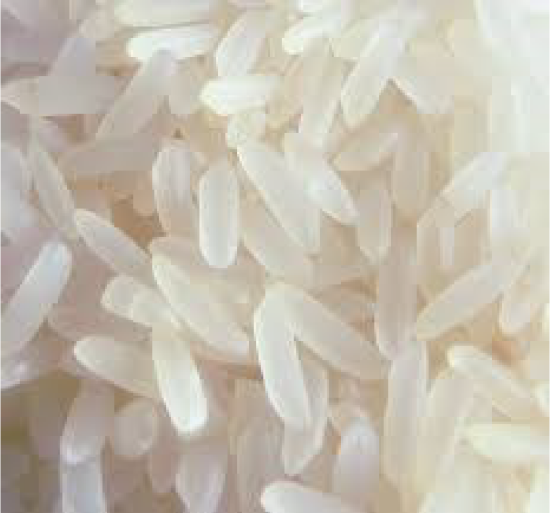
Arborio Rice
Arborio is a round, short-grain rice used primarily in Italian dishes such as risotto. It is very sticky, with a white color and mild flavor.
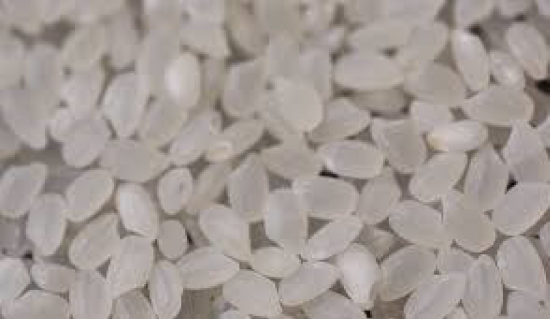
Basmati Rice
Basmati is one of the finest long-grain rice in the world. It grows in the Himalayan foothills and is preferred in Indian cuisine. It is highly aroma tic, with a sweet, delicate flavor and a creamy yellow color. Basmati rice is usually aged to improve its aromatic qualities and should be washed well before cooking. Jasmine rice is another aromatic long-grain rice. Similar to basmati, it is grown in Thailand and used throughout Southeast Asia.
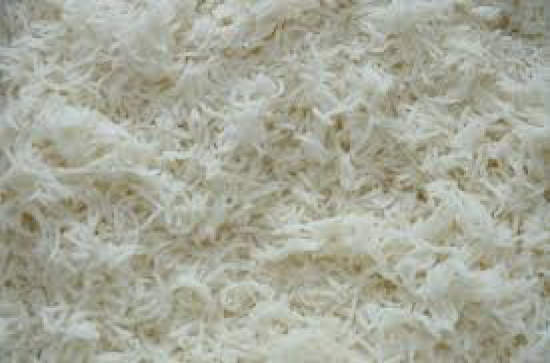
Brown Rice
Brown rice is the whole natural grain of rice. Only the husk has been removed. Brown rice has a nutty flavor; its chewy texture is caused by the high-fiber bran. Brown rice absorbs more water and takes longer to cook than white rice.
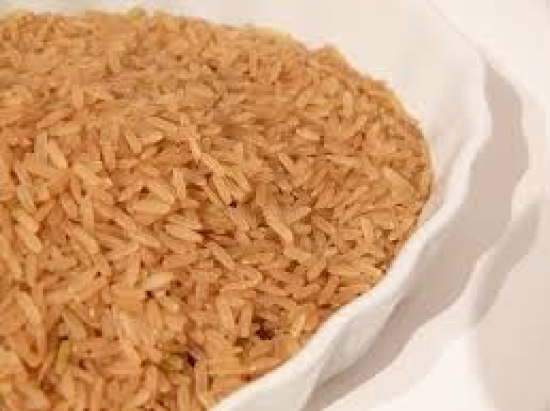
Sticky Rice
Sticky rice is a short-grain rice used in many Asian cuisines. The short grains are fat and round with a high starch con tent and a pearly white color. When cooked, the grains tend to clump together, forming a sticky mass. Sticky rice must be soaked for several hours before being cooked. Also known as glutinous rice or sweet rice, it can be ground into flour and used for dumplings and pastries. Japanese sake and mirin and Chinese ‘Shaoxing’ are made from fermented sticky rice, as is rice vinegar.
Wild Rice
Wild rice is prepared in the same manner as traditional rice, although it is actually the seed of an unrelated reed-like aquatic plant. Wild rice has lo ng, slender grains with a dark brown to black color. It has a nuttier flavor and chewier texture than traditional rice. Three grades are available: giant (the best quality, with very long grains); fancy (a medium-sized grain, suitable for most purposes); and select (a short grain, suitable for soup s, pancakes or baked goods). Cultivated in California, Idaho and Washington, it is generally served with game, used as a stuffing for poultry, or, combined with regular rice for a side dish. Wild rice is expensive, but small quantities are usually sufficient.
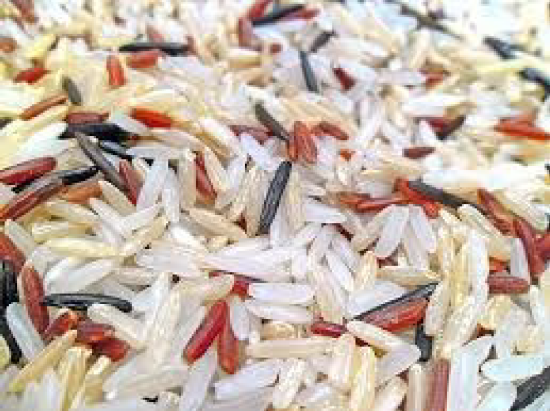
Guidelines for Cooking Rice
Rice may be rinsed before cooking to remove dirt and debris, but doing so also removes some of its nutrients. It is not necessary to rinse most American-grown rice, which is generally clean and free of insects.
Rice may also be soaked before cooking. Soaking softens the grains, removes some starch and speeds cooking. The standard ratio for cooking rice is two parts liquid to one part rice. The actual ratio varies, however, depending on the type of rice.
Note: Once cooked, rice is highly perishable. Because of its neutral pH and high protein content, cooked rice is a potentially hazardous food. To avoid the risk of food-borne illnesses, be sure to hold hot rice at 135° F (57°C) or higher. Leftover rice must be quickly cooled and stored at 41°F (S°C) or below Leftover rice must be reheated to 165°F (74°C) or higher.
Cooking Rice
| RICE TYPE | RATIO RICE:WATER | PREPARATION | COOKING TIME (SIMMERING) | YIELD FROM 1 CUP RAW RICE |
|---|---|---|---|---|
| Arborio | 1:2.5-3 | Do not rinse or soak | 15-20 min | 2 1/2-3 c. (560-675 ml) |
| Basmati | 1:1.75 | Rinse well; soak | 15 min | 2 c. (675 ml) |
| Brown, long-grain | 1:2.5 | Do not rinse; may soak | 45-50 min | 3-4 c. (675-900 ml) |
| Converted | 1:2.5 | Do not rinse | 20-25 min | 3-4 c. (675-900 ml) |
| White, long-grain (regular milled) | 1:2 | Do not rinse | 15 min | 3 c. (675 ml) |
| Wild | 1:3 | Rinse | 35-60 min., depending on grade | 3-4 c. (675-900 ml) |
Wheat
Wheat is most often milled into the wide range of flours. Wheat and products derived from it are also used as starchy side dishes or ingredients in so ups, salads, ground meat dishes and breads. These products include cracked wheat, bulgur and couscous. When cooked, they are slightly chewy with a mild flavor. All should be fluffy; none should be soggy or sticky.
Wheat germ and wheat bran are widely available and highly touted for their nutritional values. Bran and germ are not gene rally used plain, but may be added to bread or other cooked dishes.
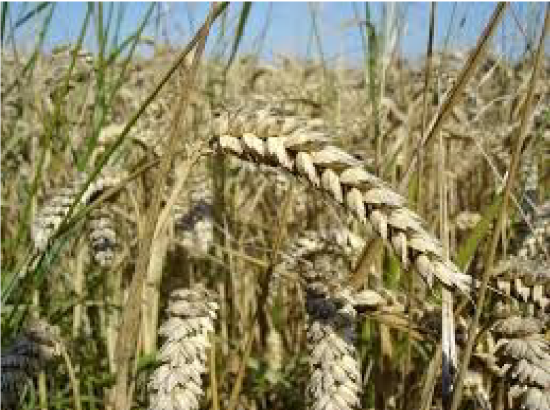
Cracked Wheat
Cracked wheat is the whole-wheat kernel (known as a berry) broken into varying degrees of coarseness. It is not precooked, and the kernel's white interior should be visible. The bran and germ are still intact, so cracked wheat has a great deal of fiber but a short shelf life. Whole-wheat berries must be soaked for several hours before cooking. Cracked wheat can be fully cooked by long, gentle simmering.
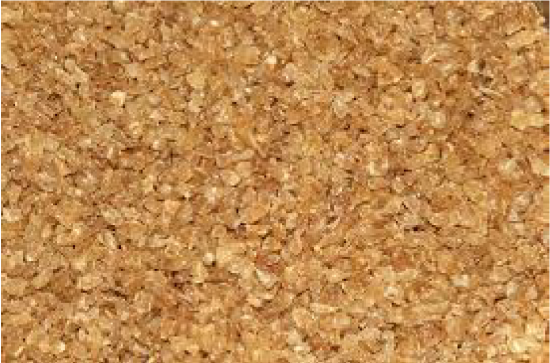
Bulgur
Bulgur is a wheat berry that has had the bran removed; it is then steam cooked, dried and ground into varying degrees of coarseness. Bulgur has a nutlike flavor and texture; it is a uniform golden-brown color (uncooked cracked wheat is not) and requires less cooking time than cracked wheat. Generally, cracked wheat and bulgur cannot be substituted for one another in recipes.
Bulgur needs only to be soaked in water, then drained, for use in salads, or briefly cooked when used in stews or pilafs. Bulgur is good with grilled meats and as an alternative to rice in stuffing and other dishes. The fine grind is most often used in packaged mixes such as tabouli; the medium grind is most often available in bulk.
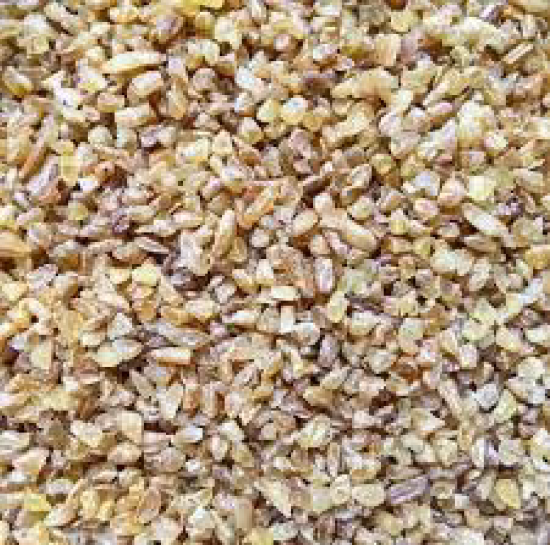
Couscous
Couscous is made by removing the bran and germ from durum wheat berries. The endosperm is then steamed, pressed to form tiny pellets and dried. Couscous is available in varying degrees of coarseness; medium-fine is the most popular. Couscous is prepared by steaming over water or stock in a pot called a couscousiere. Couscous, traditionally served with North African stews, can be used or served like rice.
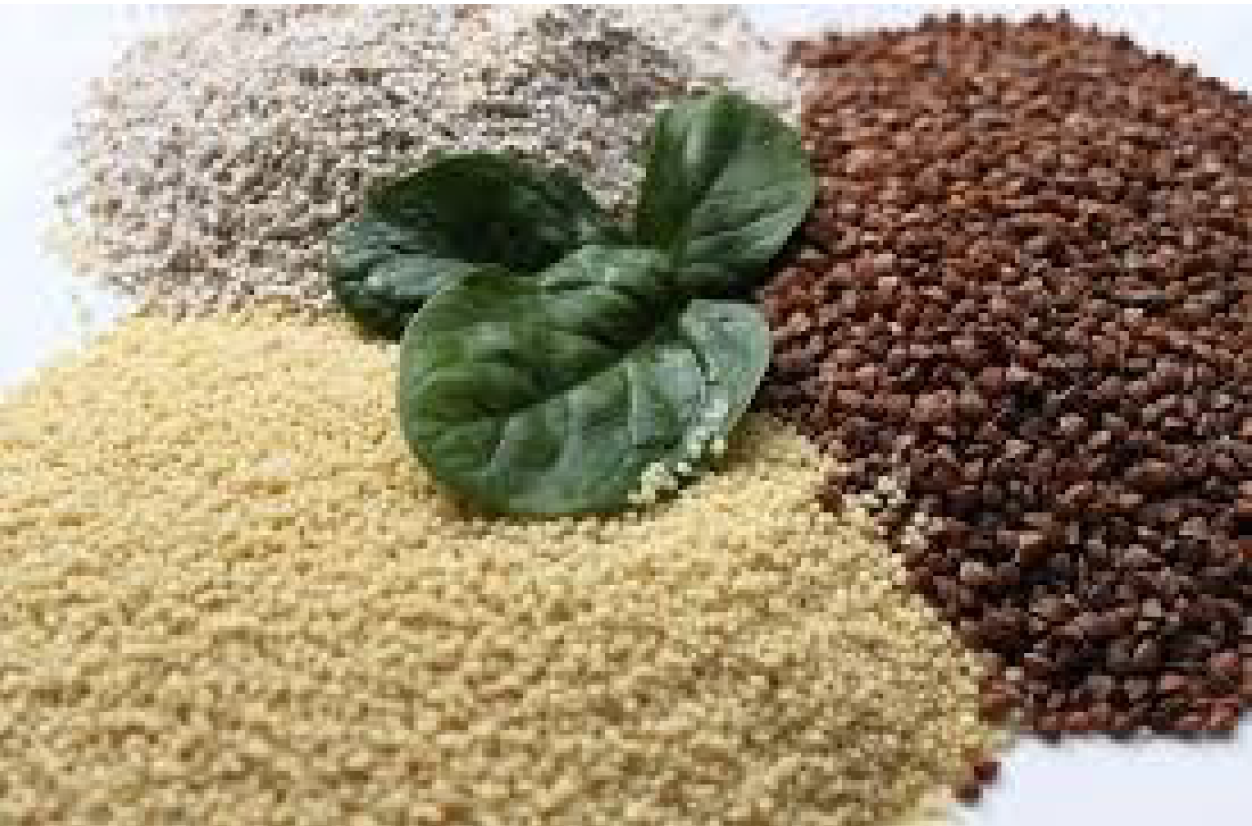
Buckwheat
Buckwheat is not a type of wheat; it is not even a grain. Rather, it is the fruit of a plant distantly related to rhubarb. Buckwheat is included here, however, because it is prepared and served in the same manner as grains. The whole buckwheat kernel is known as a groat. The product most often sold as buckwheat is actually kasha, which is a hulled, roasted buckwheat groat.
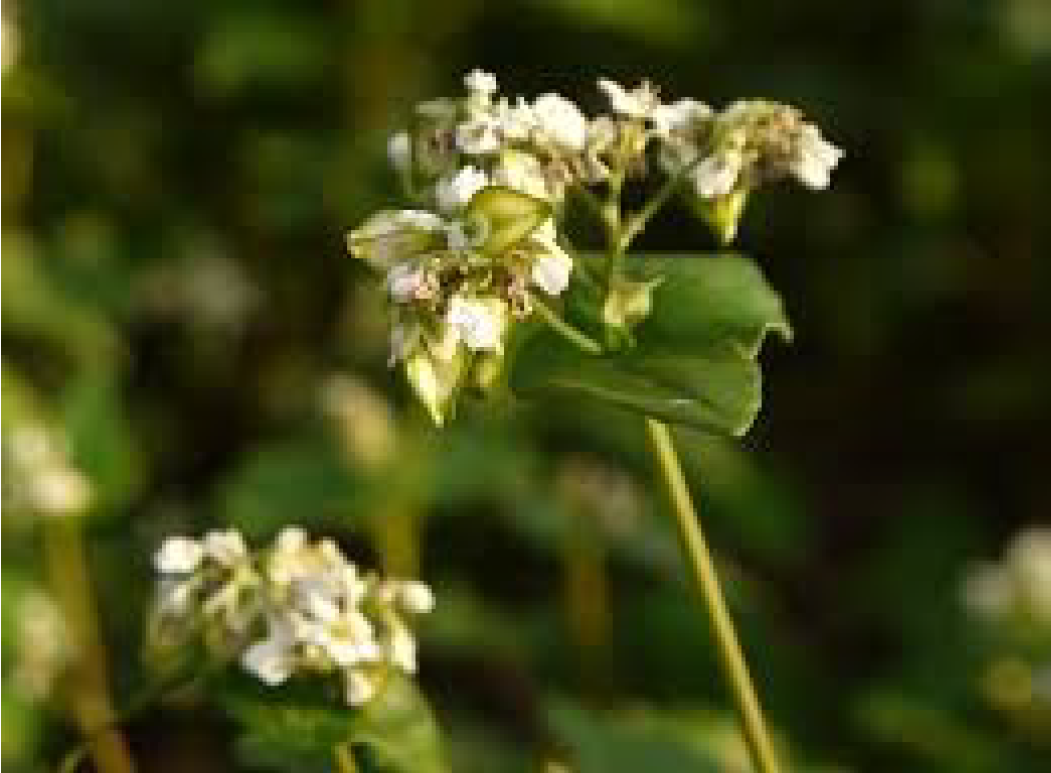
Buckwheat Plant
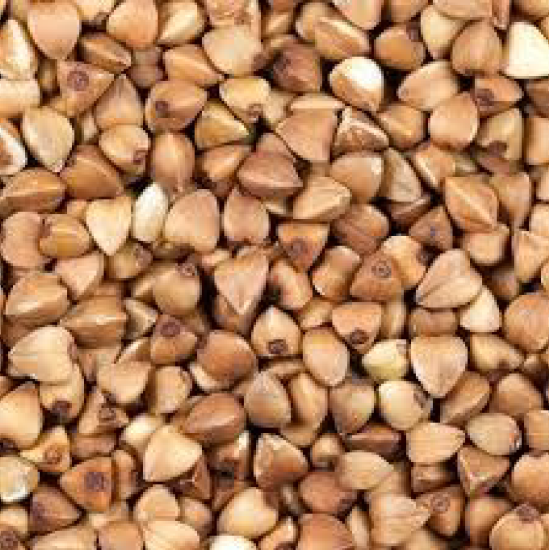
Buckwheat Groat
Kasha
Kasha is reddish brown with a strong, nutty, almost scorched flavor. It is available whole or ground to varying degrees of coarse ness. Whole kasha remains in separate grains after cooking; the finer grinds become rather sticky. Kasha can be served as a side dish, usually combined with pasta or vegetables, or it can be chilled and used in salads.
Raw buckwheat groats are ground into flour typically used in pasta, blini and other pancakes. Buckwheat flour contain s no gluten-forming proteins, and it tend s to remain grainy, with a sandy texture. Therefore, it should not be substituted for all the wheat flour in breads or baked goods.
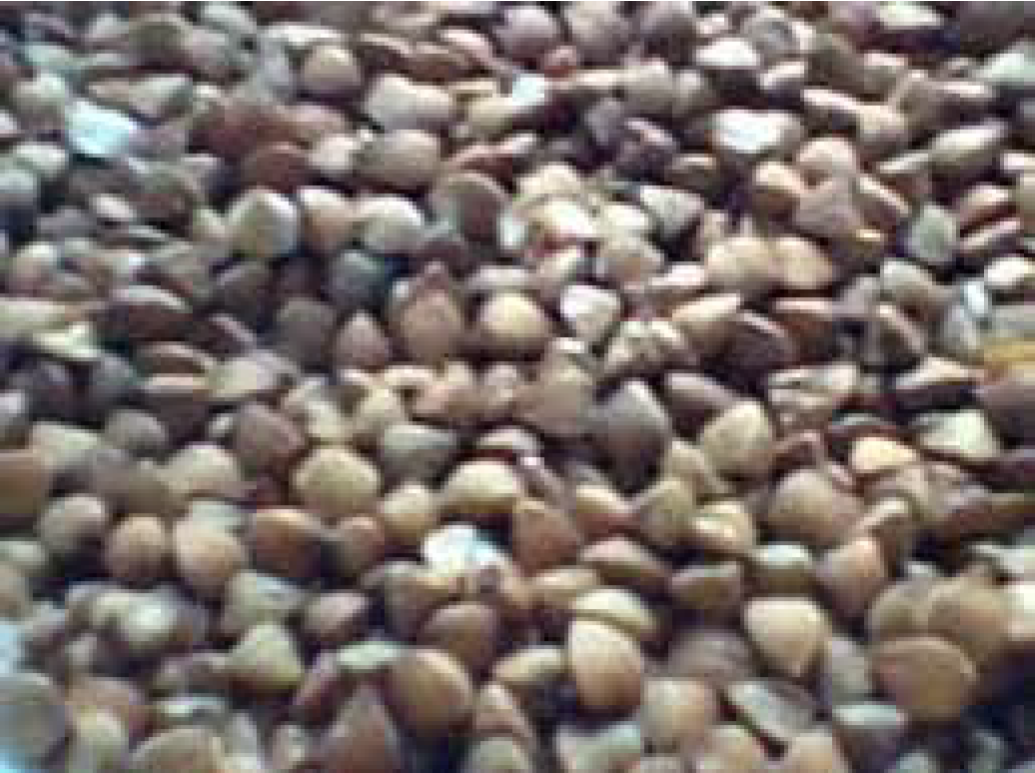
Millet
Millet is a high-protein cereal grain with a bland, slightly nutty flavor and a white color. Used principally as animal fodder in the United States, millet can be cooked and eaten like rice or toasted like buckwheat and cooked like kasha. It can also be ground for flour (when used for baking, it is best combined with wheat flour). Millet is usually sold hulled, as the husk is extremely hard.
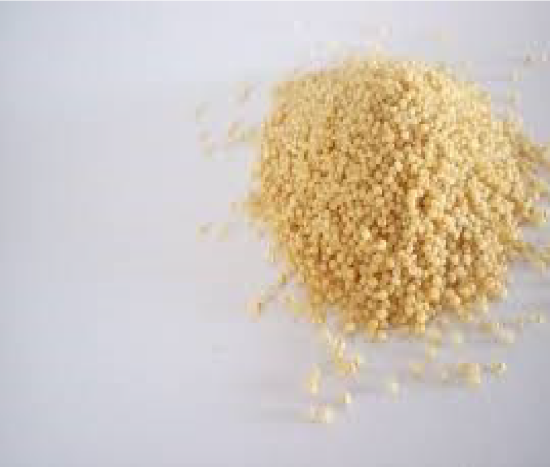
Oats
After rice, oats are probably the most widely accepted whole-grain product in the American diet. Oats are consumed daily as a hot breakfast cereal (oatmeal) and are used in breads, muffins, cookies and other baked goods.
An oat groat is the whole oat kernel with only the husk removed. It contains both the bran and germ. Steel cut oats, sometimes known, as Irish oats, are groats that are toasted and then cut into small pieces with steel blades. Rolled oats, marketed as "old-fashioned oats," are groats that have been steamed, then rolled into flat flakes. Quick-cooking oats are simply rolled oats cut into smaller pieces to reduce cooking time. Instant oats are partially cooked and dried before rolling so that they need only to be rehydrated in boiling water. Rolled oats and quick-cooking oats can be used interchangeably, but instant oats should not be substituted in most recipes. Oat bran is the outer covering of a hulled oat. It is available as a separate product, although rolled and cut oats do contain some oat bran.
The term oatmeal is commonly used to refer to both processed groats and the cooked porridge made from them. The processed groats known as oatmeal are a gray-white color with a starchy texture and sweet flavor. They cook into the soft, thick porridge with a robust flavor called oatmeal.
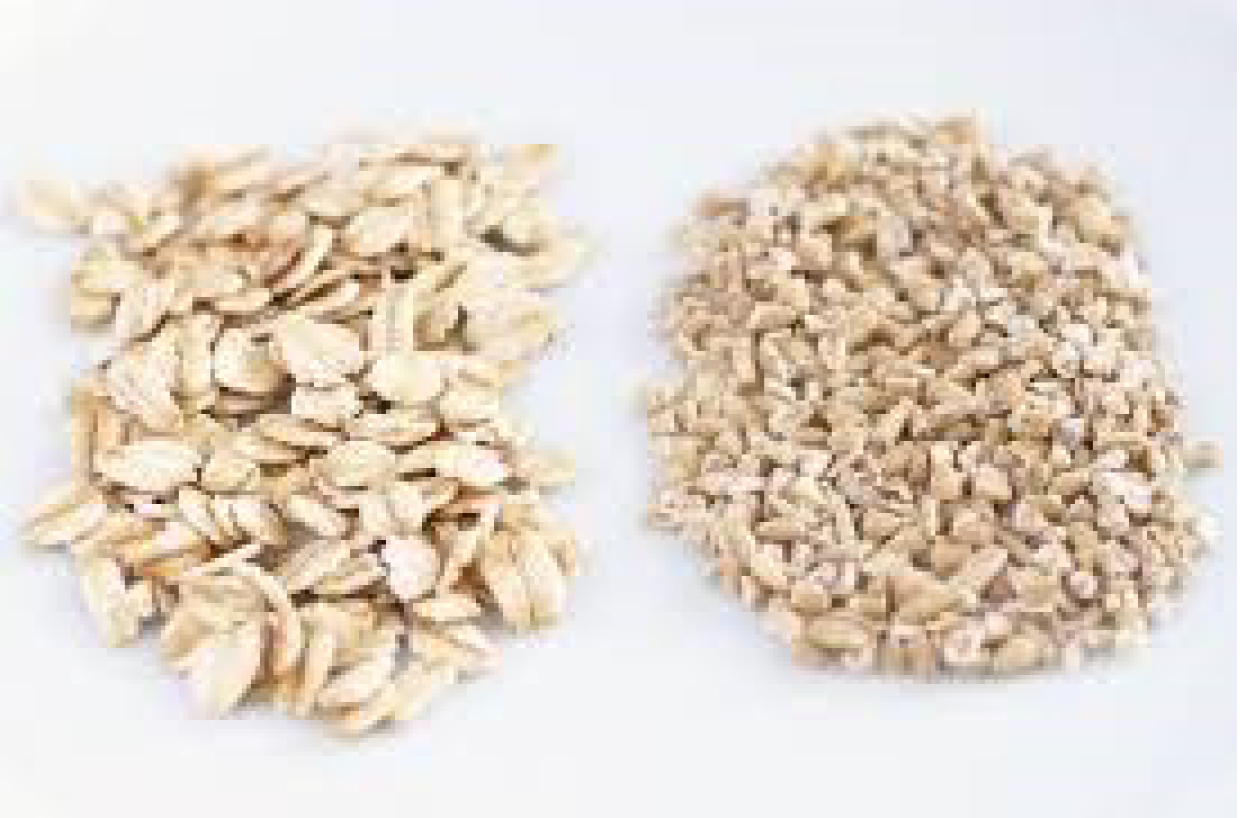
Rolled Steel Cut
Quinoa
Quinoa is native to the South American Andes and was a common food of the Incas, who referred to it as the "mother grain." Although not botanically a true grain, quinoa's tiny seeds are treated as such. The grains (seeds) are small, flattened spheres, approximately 1/16 inch (15 millimeters) in diameter, ringed with the germ. They become translucent when cooked and have a slightly smoky or sesame-like flavor. Several varieties of quinoa are available, ranging in color from dark brown to almost white. The larger whiter varieties are most common and are considered superior.
Quinoa seeds have a natural, bitter-tasting coating, which protects them from birds and insects. Consequently, they should be placed in a fine-meshed colander and rinsed well with cool water for several minutes before use. Quinoa can then be cooked like rice, and will absorb about twice its volume of water. For a nuttier taste, toast the grain in a hot dry pan for about 5 minutes before adding the liquid. Quinoa can also be eaten as a hot breakfast cereal served in lieu of rice. It also finds use as a thickener for soups, stews, and in salads, casseroles, breads and desserts. Quinoa flour, ground from whole seeds, has a delicate nutty flavor. A gluten-free product, it is suitable for anyone bothered by wheat allergies. Quinoa is marketed as the world's "super grain" because the seeds form a complete protein (with all of the essential amino acids) and contain important vitamins and minerals as well as carbohydrates and fat. Quinoa should be kept in the refrigerator or freezer for long-term storage. The leaves of the quinoa plant are similar to spinach and can be eaten as a vegetable.
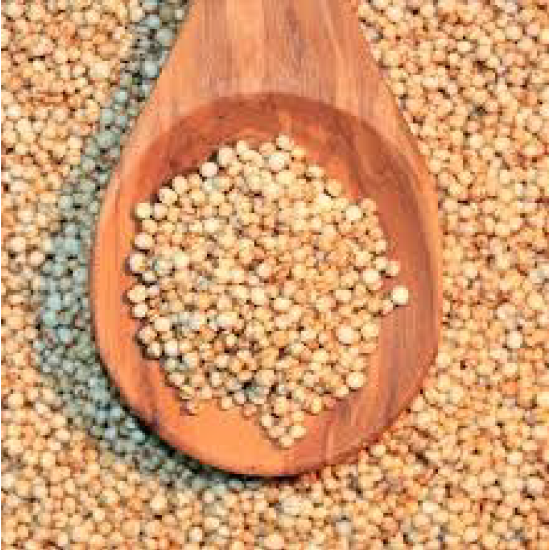
Nutrition
Grains are an excellent source of vitamins, minerals, proteins and fiber. The amount of milling or refining and the method of preparation affect their nutritional values, however. Unrefined and less-refined grains are excellent sources of dietary fiber. Rice is also quite nutritious: It is low in sodium and calories and contains all the essential amino acids. Some grains, especially white rice and oats, are usually enriched with calcium, iron and B-complex vitamins.


